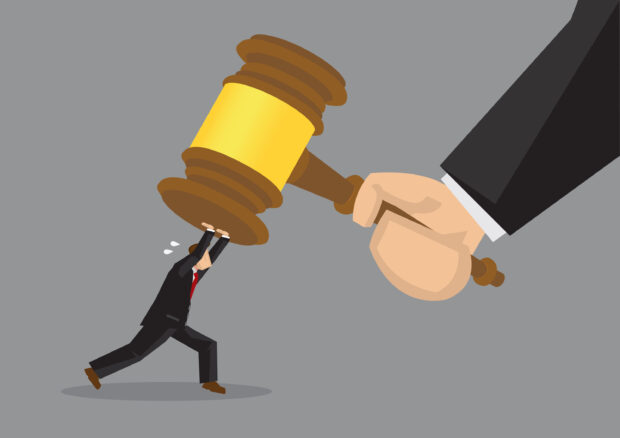In May 2022, a judge at the U.S. District Court in Texas ruled that IBM had breached a 2015 licensing agreement signed with a competitor, BMC Software Inc., awarding BMC more than $1.6 billion in damages. IBM subsequently appealed the ruling. In April 2024, a federal appeals court in New Orleans overturned the judgment. Although BMC lost the appeal, there was a silver lining: A group of insurance carriers led by Liberty Mutual had insured the possibility of an appeals court reversal.
Executive Summary
“There’s this pattern in the insurance industry where someone comes up with a new product generating big demand, everyone jumps in to grab market share, a ton of policies are sold, and three years later it’s a smoldering crater because no one fine-tuned the actuarial.”The words of an unidentified speaker familiar with the Judgment Preservation Insurance market sum up the story of how a unique but very risky litigation insurance policy ran into trouble, following a particularly gulping loss after a period of irrational exuberance. A course correction may be needed for the niche market to stabilize, brokers told journalist Russ Banham.
According to Bloomberg Law, BMC’s insurance coverage provides between $500 million and $750 million, with Liberty Mutual picking up the tab for at least $100 million and possibly $150 million. (“Liberty, Insurers Take Hit on $1.6 Billion IBM Judgment Policy” by Emily R. Siegel, May 8, 2024, Bloomberg Law) The insurance policy providing the consolation prize is called judgment preservation insurance, or JPI. JPI covers the possibility that an award granted at the trial court level could be reversed or reduced on appeal. The bespoke product guarantees the policyholder an agreed-upon financial amount, a figure typically in the tens to hundreds of millions of dollars—enough money in many cases to buffer the financial impact of so-called “nuclear verdicts.”
The number of JPI policies sold is unknown, as the dealings between the buyer, broker and insurance companies are private and there are no regulations requiring disclosure. Approximately 30-40 individual insurers, some under the cover of an MGA (managing general agency) or an MGU (managing general underwriter), share in the risk of a sizable JPI loss via an insurance tower of coverage, said Joseph Menning, senior vice president at insurance broker HUB International, who specializes in lawyers, accountants and contingent liability risks. “The JPI market is big, given the possibility of [absorbing] a nine-figure loss, which tells you how much insurance capacity is out there for the right risks,” Menning said.
That capacity is now shrinking, following the successful IBM appeal and a series of other possible nine-figure losses. Jonathan Stroud, general counsel at Unified Patents, an organization formed to protect against frivolous patent litigation, said BMC’s JPI policy is “at least the third such large known loss to hit the market. There may have been half a dozen other reversals or more covered by the insurance, but the JPI market won’t know until there is some sort of forced disclosure [of the policy’s existence].”
“Obviously, when you have a few carriers putting down their pens, it makes it more challenging to put a tower together.”
Joseph Menning, HUB International
Other individuals interviewed for this article agreed that the JPI market has suffered at least three large losses, declining to mention the names of the policyholders. Stroud alleged that one of the insureds is VLSI Technologies, whose $2.2 billion judgment in its infringement lawsuit against Intel Corporation was reversed on appeal in November 2023. “VLSI is insured for $300 million,” he said. “Evidence of the JPI policy has not been publicly disclosed, but it’s widely known to be insured.” VLSI could not be reached for comment.
Aside from BMC and allegedly VLSI, two other companies have purchased JPI insurance. One is Appian Corporation, which The Wall Street Journal reported in October 2023 “will get paid at least $500 million” from its JPI insurance policy if a $2 billion judgment in the cloud computing company’s lawsuit against competitor Pegasystems is overturned on appeal. (“The Niche Insurance Policy Behind a Software Company’s Big Legal Payout” by Kristin Broughton, Wall Street Journal, Oct. 17, 2023, subscription required) The other is law firm Quinn Emmanuel, which was ordered by a federal court to disclose evidence of its JPI policy, purchased to protect a $185 million fee award upon appeal.
These varied developments have reverberated across the JPI market, compelling Liberty Mutual to pause underwriting the insurance (according to Insurance Insider) and back out of two potential litigation deals (according to Bloomberg Law). Insurance brokers confirmed that other insurers in the market have decreased their capital levels of participation in the aforementioned insurance towers.
“Liberty Mutual Insurance does not publicly discuss individual commercial insurance customers,” a spokesperson for Liberty Mutual said when asked to confirm the media reports and to comment on its current appetite for the JPI market.
“Obviously, when you have a few carriers putting down their pens, it makes it more challenging to put a tower together,” said Menning. “Some insurers decided to stop writing [JPI], and others are pausing. We’re also seeing an increased emphasis on retentions, rates and attachment points [the point at which one insurer’s liability ends and another insurer’s liability begins].”
Sharing this opinion is Ilan Peress, a transactional risk insurance broker and producer at Brown & Brown, who also specializes in JPI and other litigation insurance products. “Carriers are concerned about putting up too much capacity, resulting in reductions in the [insurance coverage] limits on a per policy basis,” he said.
Ilan Peress, Brown & Brown
An insurer that provided $100 million in capacity pre-IBM’s appeal reversal now caps the limit to $50 million and even $25 million, Peress said. “Added up, the towers that used to be as high as $700 million will come down significantly. Insuring very large judgments, the purpose of JPI, may become uninsurable.”
Novel and Nuanced
JPI is one of several innovative litigation insurance policies developed by insurance brokers and carriers to cover significant portions of catastrophic litigation losses. Others include adverse judgment insurance, which protects a company that becomes a defendant in future litigation, and so-called “after the event” insurance, which absorbs legal expenses incurred in pursuing or defending a lawsuit. Insurance broker Aon lists six separate litigation risk insurance solutions on its website. These products are touted in numerous articles as standard litigation risk mitigation tools.
It is not uncommon for the purchase of JPI insurance to involve third-party litigation financing provided by a hedge fund or other investment entity. The capital funds plaintiffs to pay litigation-related expenses in return for a portion of the settlement or judgment.
Andy Lundberg, managing director at Burford Capital, a provider of such legal financing products, said the firm will finance the cost of the insurance premium for a JPI policy, depending on its risk analyses. Burford Capital also will monetize a portion of the settlement or judgment, knowing it is secured by the JPI policy.
 “JPI and legal finance are complementary products; both deal in legal risk, but the water flows in different directions.”
“JPI and legal finance are complementary products; both deal in legal risk, but the water flows in different directions.”
Andy Lundberg, Burford Capital
“JPI and legal finance are complementary products; both deal in legal risk, but the water flows in different directions,” said Lundberg. He explained that Burford Capital provides capital to a JPI policyholder in the hope of receiving it back plus the firm’s premium, whereas a JPI insurer receives money from the policyholder, hoping to never pay out a claim or pay much later rather than sooner.
Related article: How Legal Finance Adds Value to Judgment Preservation Insurance
Menning agreed with the complementary value provided by the two different markets. “By picking up the cost of the premium and monetizing a portion of the judgment at a lower rate than insureds would get if there was no JPI policy in place, third-party litigation financing firms put cash in the insured’s pockets when needed most—to run the business and accomplish their objectives,” he said.
The capital provided by Burford Capital for this purpose is a significant sum. “It can be tens of millions of dollars,” said David Perla, the firm’s co-chief operating officer. Given recent developments in the JPI insurance market following the IBM-BMC appeal reversal, Perla and other interviewees believe that JPI premiums are quickly heading higher. “It used to run 7 percent to 10 percent of the face value [of the policy], but is now moving into the teens to 20 percent,” Perla said.
Jonathan Stroud, Unified Patents
“It’s definitely tougher to see policies with a 10 percent rate on line, with things closer to 14-15 percent,” said Menning, calculating that a $100 million JPI policy would cost a buyer $14 million to $15 million, as opposed to $10 million previously. “The retention also could be higher, meaning if the policy triggers, the insured will eat a larger amount of the loss.”
Peress concurred that premiums are rising into the 20 percent range, commenting that further rate hikes would be counterproductive. “There’s a ceiling on how much you can charge before market efficiency is eroded,” he said. “There’s only so much insurance risk that carriers can take, in terms of the premium offset. The insurance is not cheap to begin with, in terms of funding it through third-party litigation finance.”
A Bubble Emerges
Insurance brokers contended that underwriting JPI policies to arrive at an appropriate premium and limits is an exhaustive process. “An underwriter will normally conduct an interview with the prospective insured’s counsel and review the relevant pleadings and [undertake] some discovery,” Menning explained. “Outside counsel, normally a subject matter specialist, will conduct its own review of the risk, [entailing] additional calls with the prospective insured and inside counsel along with a review of relevant documents.”
A focus of underwriting is to assess the percentage of trial court judgments that have been reversed on appeal. A 2019 study indicates that approximately 90 percent of appellate court decisions affirm lower court rulings, whereas a U.S. government report from 2016 suggests that fewer than 9 percent of appeals result in a reversal. In their due diligence, carriers evaluate possible errors made during the original trial court decisions. A typical appeal, according to the U.S. Department of Justice, is a decision made by a trial court judge that was incorrect. “It’s a difficult thing to handicap since appellate litigation is very difficult to assess and score,” said Stroud.
This difficulty and the possibility of an eight-figure and nine-figure loss cautioned carriers from participating in the JPI market at the outset, less than 10 years ago. Premiums were high, buyers were few, and losses were potentially catastrophic. As Stroud put it, “Not a lot of carriers were competing to offer the product. Premiums were so high it didn’t make sense to buy it. What happened to change things was when litigation funding became available [to finance the cost of the premium].”
As carriers became comfortable insuring the risk, business picked up—in large part due to the efforts of insurance brokers to articulate the value of the insurance to litigants. “The brokers really started a push toward sales,” said Stroud. “Their timing was good, as eye-popping verdicts were happening. People started to think maybe this is something, maybe we’re getting left out by not buying the insurance. The brokers capitalized on these fears.”
Spurring many insurance brokers was the possibility of high-dollar commissions on high-premium policies. “The commercial incentives to talk up the product were enormous; brokers could stand to make hundreds of thousands of dollars on a single policy,” Stroud said.
Human behavior being what it is, irrational exuberance soon seized the market, driving premiums higher than the insurance justified, he said. “The brokers were selling policies and getting the rates as high as possible that, more likely than not, weren’t worth what they were saying they were worth,” he said.
Three years ago, the market turned in the opposite direction, possibly to entice and secure more policyholders. “There was incentive for brokers to drive things down as cheaply as possible, to get creative with the numbers,” said Stroud. “A fair number of products were sold that were destined to be reversed. Rates were too good to be true, too attractive to say no. Heck, I would have said yes.”

“These are the most sophisticated insurance companies in the world, and somehow, they were persuaded by a bunch of brokers to radically misprice their offerings. There’s this pattern in the insurance industry where someone comes up with a new product generating big demand, everyone jumps in to grab market share, a ton of policies are sold, and three years later it’s a smoldering crater because no one fine-tuned the actuarial.”
Burford Capital’s Perla agreed. “Three years ago, Andy Lundberg and [Burford Capital CEO] Chris Bogart commented that this stuff was not priced right, it was not priced to risk,” he said. “If you can buy it, go for it, they said.”
Others share this opinion. A discussion with an individual familiar with the JPI market whose business dealings might be affected by his comments had this to say on background: “These are the most sophisticated insurance companies in the world, and somehow, they were persuaded by a bunch of brokers to radically misprice their offerings. There’s this pattern in the insurance industry where someone comes up with a new product generating big demand, everyone jumps in to grab market share, a ton of policies are sold, and three years later it’s a smoldering crater because no one fine-tuned the actuarial.”
Treading Water
Since the IBM-BMC appeal reversal, the JPI bubble has burst, said Stroud. “I’m not alone in saying this is the case,” he said. “The market is not very transparent, so it might take a while [for participants] to fully understand reality.”
He attributed the reluctance among carriers to provide the same levels of capacity they provided prior to the recent JPI loss to an “information cycle of the bad not being heard and the good being over-highlighted. Insurers signed on for bad products; many are now saying they never should have supported this.”
To turn the tide, Peress said a market “course correction” is needed; otherwise, it will be difficult to piece together enough insurance capacity to assemble insurance towers large enough to cover nuclear verdicts, the intent of the insurance. “As opposed to these one-hit wonders sold by A-type personalities seeking personal bonus checks, we need to develop a long-term stable and sustainable market.”
Asked how this might come to fruition, Peress said the JPI market could diversify into litigation types beyond the usual intellectual patent (IP), business-to-business disputes, breach of contract and personal injury judgments (with IP being the primary type of litigation covered by the insurance by far). “Rather than an all-or-nothing, zero-sum game, the industry needs to broaden its appetite on a sector-by-sector basis and by types of lawsuits to diversify the risks,” he explained, citing manufacturing, health care, real estate and software as sectors, and divorce, mass torts, product liability and antitrust as litigation types, among others.
As the insurance market sorts out its challenges and opportunities for the future, the demand among litigants for JPI has not wavered, despite the BMC insured loss. “It’s still strong, with a lot of companies, general counsels and litigators just becoming aware of it now,” said Menning. “There’s also a huge swath of potential purchasers that don’t know it exists or fully appreciate what it can do. I have two policies binding in the next two to three weeks in the mid-eight-figure range. Deals can still be done.”
Asked if the JPI market going forward has enough capacity to support nine-figure nuclear verdicts, he said it was unlikely. “It’s possible that for the absolute right risk it could get to nine figures, but that would be the exception and not the rule.”





















 Better Results Ahead? Technology Improvements in Commercial Fleets
Better Results Ahead? Technology Improvements in Commercial Fleets  State Farm Stronger as Underwriting Losses Shrink—But Not in California
State Farm Stronger as Underwriting Losses Shrink—But Not in California  Performance Review: Why Insurers Struggle to Underwrite, Price and Reserve for Commercial Auto Risks
Performance Review: Why Insurers Struggle to Underwrite, Price and Reserve for Commercial Auto Risks  Hawaii Islands Sinking Faster in Some Areas, Increasing Flood Risk
Hawaii Islands Sinking Faster in Some Areas, Increasing Flood Risk 

